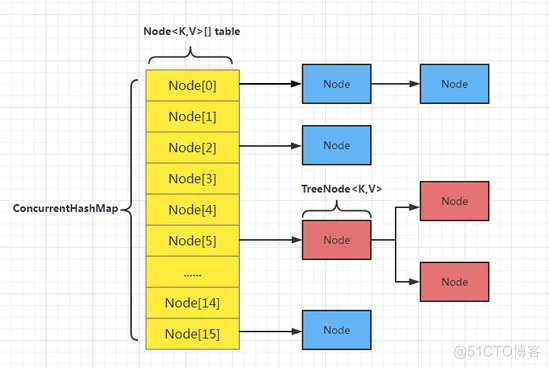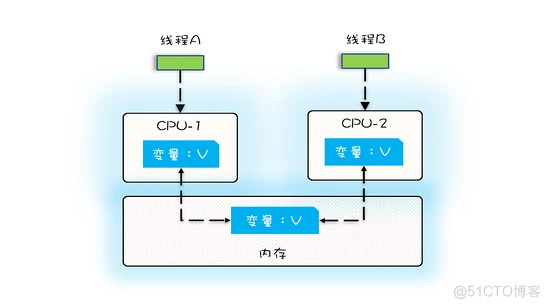ConCurrentHashMap 是一个支持高并发集合,常用的集合之一,在 jdk1.8 中 ConCurrentHashMap 的结构和操作和 HashMap 都很类似:
- 数据结构基于数组+链表/红黑树 。
- get 通过计算hash值后取模数组长度确认索引来查询元素。
- put 方法也是先找索引位置,然后不存在就直接添加,存在相同key 就替换。
- 扩容都是创建新的table 数组,原来的数据转移到新的table 数组中。
唯一不同的是, HashMap 不支持并发操作, ConCurrentHashMap 是支持并发操作的。所以 ConCurrentHashMap 的设计也比 HashMap 也复杂的多,通过阅读 ConCurrentHashMap 的源码,也更加了解一些并发的操作,比如:
<pre class="hljs java">volatile
CAS
synchronized
</pre>
详见 HashMap 相关文章:
详解HashMap源码解析(上)
详解HashMap源码解析(下)
数据结构
ConCurrentHashMap 是由 数组+链表/红黑树 组成的:

其中左侧部分是一个 哈希表 ,通过 hash算法 确定元素在数组的下标:
transient volatile链表是为了解决 hash冲突 ,当发生冲突的时候。采用 链表法 ,将元素添加到链表的尾部。其中 Node 节点存储数据:
static class Node<K,V> implements Map.Entry<K,V> {final int hash;
final K key;
volatile V val;
volatile Node<K,V> next;
Node(int hash, K key, V val, Node<K,V> next) {
this.hash = hash;
this.key = key;
this.val = val;
this.next = next;
}
}
Node 节点包含:
hash主要属性字段
// 最大容量int MAXIMUM_CAPACITY = 1 << 30;
// 初始化容量
int DEFAULT_CAPACITY = 16
// 控制数组初始化或者扩容,为负数时,表示数组正在初始化或者扩容。-1表示正在初始化。其他情况-n表示n线程正在扩容。
private transient volatile int sizeCtl;
// 装载因子
float LOAD_FACTOR = 0.75f
// 链表长度为 8 转成红黑树
int TREEIFY_THRESHOLD = 8
// 红黑树长度小于6退化成链表
int UNTREEIFY_THRESHOLD = 6;
获取数据get
public V get(Object key){Node<K,V>[] tab; Node<K,V> e, p; int n, eh; K ek;
// 计算hash值
int h = spread(key.hashCode());
// 判断 tab 不为空并且 tab对应的下标不为空
if ((tab = table) != null && (n = tab.length) > 0 &&
(e = tabAt(tab, (n - 1) & h)) != null) {
if ((eh = e.hash) == h) {
if ((ek = e.key) == key || (ek != null && key.equals(ek)))
return e.val;
}
// eh < 0 表示遇到扩容
else if (eh < 0)
return (p = e.find(h, key)) != null ? p.val : null;
// 遍历链表,直到遍历key相等的值
while ((e = e.next) != null) {
if (e.hash == h &&
((ek = e.key) == key || (ek != null && key.equals(ek))))
return e.val;
}
}
return null;
}
- 获取数据流程:
- 调用spread 获取hash 值,通过(n - 1) & h 取余获取数组下标的数据。
- 首节点符合就返回数据。
- eh<0 表示遇到了扩容,会调用正在扩容节点ForwardingNode 的find 方法,查找该节点,匹配就返回。
- 遍历链表,匹配到数据就返回。
- 以上都不符合,返回null 。
get如何实现线程安全
get方法里面没有使用到锁,那是如何实现线程安全。主要使用到了 volatile 。
- volatile
一个线程对共享变量的修改,另外一个线程能够立刻看到,我们称为 可见性 。
cpu 运行速度比内存速度快很多,为了均衡和内存之间的速度差异,增加了 cpu缓存 ,如果在cpu缓存中存在 cpu 需要数据,说明命中了 cpu 缓存,就不经过访问内存。如果不存在,则要先把内存的数据载入到 cpu 缓存中,在返回给 cpu 处理器。
在 多核cpu 的服务器中,每个 cpu 都有自己的缓存, cpu 之间的缓存是不共享的。 当多个线程在不同的 cpu 上执行时,比如下图中, 线程A 操作的是 cpu-1 上的缓存, 线程B 操作的是 cpu-2 上的缓存,这个时候, 线程A 对 变量V 的操作对于 线程B 是 不可见的 。

但是一个变量被 volatile 声明,它的意思是:
告诉编译器,对这个变量的读写,不能使用cpu缓存,必须从内存中读取或者写入。
上面的变量V被 volatile 声明,线程A在cup-1中修改了数据,会直接写到内存中,不会写入到cpu缓存中。而线程B无法从cpu缓存读取变量,需要从主内存拉取数据。
- 总结:
volatile 在 get 应用
- table 哈希表
使用 volatile 声明数组,表示 引用地址 是 volatile 而不是 数组元素 是 volatile 。
既然不是 数组元素 被修饰成 volatile ,那实现线程安全在看 Node 节点。
- Node 节点
final int hash;
final K key;
volatile V val;
volatile
其中 val 和 next 都用了 volatile 修饰,在多线程环境下,线程A修改节点 val 或者新增节点对别人线程是 可见的 。
所以 get 方法使用无锁操作是可以 保证线程安全 。
既然 volatile 修饰数组对 get 操作没有效果,那加在 volatile 上有什么目的呢?
是为了数组在扩容的时候对其他线程具有可见性。
- jdk 1.8 的get操作不使用锁,主要有两个方面:
- Node节点的val 和next 都用volatile 修饰,保证线程修改或者新增节点对别人线程是可见的。
- volatile 修饰table 数组,保证数组在扩容时其它线程是具有可见性的。
添加数据put
put(K key, V value) 直接调用 putVal(key, value, false) 方法。
public V put(K key, V value){return putVal(key, value, false);
}
putVal() 方法:
final V putVal(K key, V value, boolean{// key或者value为空,报空指针错误
if (key == null || value == null) throw new NullPointerException();
// 计算hash值
int hash = spread(key.hashCode());
int binCount = 0;
for (Node<K,V>[] tab = table;;) {
Node<K,V> f; int n, i, fh;
if (tab == null || (n = tab.length) == 0)
// tab为空或者长度为0,初始化table
tab = initTable();
// 使用volatile查找索引下的数据
else if ((f = tabAt(tab, i = (n - 1) & hash)) == null) {
// 索引位置没有数据,使用cas添加数据
if (casTabAt(tab, i, null,
new Node<K,V>(hash, key, value, null)))
break; // no lock when adding to empty bin
}
// MOVED表示数组正在进行数组扩容,当前进行也参加到数组复制
else if ((fh = f.hash) == MOVED)
tab = helpTransfer(tab, f);
else {
V oldVal = null;
// 数组不在扩容和也有值,说明数据下标处有值
// 链表中有数据,使用synchronized同步锁
synchronized (f) {
if (tabAt(tab, i) == f) {
// 为链表
if (fh >= 0) {
binCount = 1;
// 遍历链表
for (Node<K,V> e = f;; ++binCount) {
K ek;
// hash 以及key相同,替换value值
if (e.hash == hash &&
((ek = e.key) == key ||
(ek != null && key.equals(ek)))) {
oldVal = e.val;
if (!onlyIfAbsent)
e.val = value;
break;
}
Node<K,V> pred = e;
// 遍历到链表尾,添加链表节点
if ((e = e.next) == null) {
pred.next = new Node<K,V>(hash, key,
value, null);
break;
}
}
}
// 红黑树,TreeBin哈希值固定为-2
else if (f instanceof TreeBin) {
Node<K,V> p;
binCount = 2;
if ((p = ((TreeBin<K,V>)f).putTreeVal(hash, key,
value)) != null) {
oldVal = p.val;
if (!onlyIfAbsent)
p.val = value;
}
}
}
}
if (binCount != 0) {
// 链表转红黑树
if (binCount >= TREEIFY_THRESHOLD)
treeifyBin(tab, i);
if (oldVal != null)
return oldVal;
break;
}
}
}
addCount(1L, binCount);
return null;
}
- 添加数据流程:
- 判断key 或者value 为null 都会报空指针错误。
- 计算hash 值,然后开启没有终止条件的循环。
- 如果table 数组为null ,初始化数组。
- 数组table 不为空,通过volatile 找到数组对应下标是否为空,为空就使用CAS 添加头结点。
- 节点的hash =-1 表示数组正在扩容,一起进行扩容操作。
- 以上不符合,说明索引处有值,使用synchronized 锁住当前位置的节点,防止被其他线程修改。
- 如果是链表,遍历链表,匹配到相同的key 替换value 值。如果链表找不到,就添加到链表尾部。
- 如果是红黑树,就添加到红黑树中。
- 节点的链表个数大于8 ,链表就转成红黑树。
ConcurrentHashMap 键值对为什么都不能为 null ,而 HashMap 就可以?
通过 get 获取数据时,如果获取的数据是 null , 就无法判断,是put时的value为null,还是找个key就没做过映射 。HashMap是非并发的,可以通过 contains(key) 判断,而支持并发的 ConcurrentHashMap 在调用 contains 方法和 get 方法的时候, map 可能已经不同了。 参考
如果数组 table 为空调用 initTable 初始化数组:
private final Node<K,V>[] initTable() {Node<K,V>[] tab; int sc;
// table 为 null
while ((tab = table) == null || tab.length == 0) {
if ((sc = sizeCtl) < 0)
// sizeCtl<0表示其它线程正在初始化数组数组,当前线程需要让出CPU
Thread.yield(); // lost initialization race; just spin
// 调用CAS初始化table表
else if (U.compareAndSwapInt(this, SIZECTL, sc, -1)) {
try {
if ((tab = table) == null || tab.length == 0) {
int n = (sc > 0) ? sc : DEFAULT_CAPACITY;
@SuppressWarnings("unchecked")
Node<K,V>[] nt = (Node<K,V>[])new Node<?,?>[n];
table = tab = nt;
sc = n - (n >>> 2);
}
} finally {
sizeCtl = sc;
}
break;
}
}
return
initTable 判断 sizeCtl 值,如果 sizeCtl 为 -1 表示有其他线程正在初始化数组,当前线程调用 Thread.yield 让出 CPU 。而正在初始化数组的线程通过 Unsafe.compareAndSwapInt 方法将 sizeCtl 改成 -1 。
initTable 最外层一直使用 while 循环,而非 if 条件判断,就是确保数组可以初始化成功。
数组初始化成功之后,再执行添加的操作,调用 tableAt 通过 volatile 的方式找到 (n-1)&hash 处的 bin 节点。
- 如果为空,使用CAS 添加节点。
- 不为空,需要使用synchronized 锁,索引对应的bin 节点,进行添加或者更新操作。
如果f的hash值为-1,说明当前f是ForwaringNode节点,意味着有其它线程正在扩容,则一起进行扩容操作。
完成添加或者更新操作之后,才执行 break 终止最外层 没有终止条件的for循环 ,确保数据可以添加成功。
最后执行 addCount 方法。
private final void addCount(long x, int{CounterCell[] as; long b, s;
// 利用CAS更新baseCoount
if ((as = counterCells) != null ||
!U.compareAndSwapLong(this, BASECOUNT, b = baseCount, s = b + x)) {
CounterCell a; long v; int m;
boolean uncontended = true;
if (as == null || (m = as.length - 1) < 0 ||
(a = as[ThreadLocalRandom.getProbe() & m]) == null ||
!(uncontended =
U.compareAndSwapLong(a, CELLVALUE, v = a.value, v + x))) {
fullAddCount(x, uncontended);
return;
}
if (check <= 1)
return;
s = sumCount();
}
// check >= 0,需要检查是否需要进行扩容操作
if (check >= 0) {
Node<K,V>[] tab, nt; int n, sc;
while (s >= (long)(sc = sizeCtl) && (tab = table) != null &&
(n = tab.length) < MAXIMUM_CAPACITY) {
int rs = resizeStamp(n);
if (sc < 0) {
if ((sc >>> RESIZE_STAMP_SHIFT) != rs || sc == rs + 1 ||
sc == rs + MAX_RESIZERS || (nt = nextTable) == null ||
transferIndex <= 0)
break;
if (U.compareAndSwapInt(this, SIZECTL, sc, sc + 1))
transfer(tab, nt);
}
else if (U.compareAndSwapInt(this, SIZECTL, sc,
(rs << RESIZE_STAMP_SHIFT) + 2))
transfer(tab, null);
s = sumCount();
}
}
}
扩容transfer
什么时候会扩容
*插入一个新的节点:
- 新增节点,所在的链表元素个数达到阈值8,则会调用treeifyBin 把链表转成红黑树,在转成之前,会判断数组长度小于MIN_TREEIFY_CAPACITY ,默认是64 ,触发扩容。
- 调用put 方法,在结尾addCount 方法记录元素个数,并检查是否进行扩容,数组元素达到阈值时,触发扩容。
不使用加锁的,支持多线程扩容。利用并发处理减少扩容带来性能的影响。
private final void transfer(Node<K,V>[] tab, Node<K,V>[] nextTab){int n = tab.length, stride;
if ((stride = (NCPU > 1) ? (n >>> 3) / NCPU : n) < MIN_TRANSFER_STRIDE)
stride = MIN_TRANSFER_STRIDE; // subdivide range
if (nextTab == null) { // initiating
try {
@SuppressWarnings("unchecked")
// 创建nextTab,容量为原来容量的两倍
Node<K,V>[] nt = (Node<K,V>[])new Node<?,?>[n << 1];
nextTab = nt;
} catch (Throwable ex) { // try to cope with OOME
// 扩容是抛出异常,将阈值设置成最大,表示不再扩容。
sizeCtl = Integer.MAX_VALUE;
return;
}
nextTable = nextTab;
transferIndex = n;
}
int nextn = nextTab.length;
// 创建 ForwardingNode 节点,作为标记位,表明当前位置已经做过桶处理
ForwardingNode<K,V> fwd = new ForwardingNode<K,V>(nextTab);
// advance = true 表明该节点已经处理过了
boolean advance = true;
boolean finishing = false; // to ensure sweep before committing nextTab
for (int i = 0, bound = 0;;) {
Node<K,V> f; int fh;
// 控制 --i,遍历原hash表中的节点
while (advance) {
int nextIndex, nextBound;
if (--i >= bound || finishing)
advance = false;
else if ((nextIndex = transferIndex) <= 0) {
i = -1;
advance = false;
}
// 用CAS计算得到的transferIndex
else if (U.compareAndSwapInt
(this, TRANSFERINDEX, nextIndex,
nextBound = (nextIndex > stride ?
nextIndex - stride : 0))) {
bound = nextBound;
i = nextIndex - 1;
advance = false;
}
}
// 将原数组中的节点赋值到新的数组中,nextTab赋值给table,清空nextTable。
if (i < 0 || i >= n || i + n >= nextn) {
int sc;
// 所有节点完成复制工作,
if (finishing) {
nextTable = null;
table = nextTab;
// 设置新的阈值为原来的1.5倍
sizeCtl = (n << 1) - (n >>> 1);
return;
}
// 利用CAS方法更新扩容的阈值,sizeCtl减一,说明新加入一个线程参与到扩容中
if (U.compareAndSwapInt(this, SIZECTL, sc = sizeCtl, sc - 1)) {
if ((sc - 2) != resizeStamp(n) << RESIZE_STAMP_SHIFT)
return;
finishing = advance = true;
i = n; // recheck before commit
}
}
// 遍历的节点为null,则放入到ForwardingNode指针节点
else if ((f = tabAt(tab, i)) == null)
advance = casTabAt(tab, i, null, fwd);
// f.hash==-1表示遍历到ForwardingNode节点,说明该节点已经处理过了
else if ((fh = f.hash) == MOVED)
advance = true; // already processed
else {
// 节点加锁
synchronized (f) {
if (tabAt(tab, i) == f) {
Node<K,V> ln, hn;
// fh>=0,表示为链表节点
if (fh >= 0) {
// 构建两个链表,一个是原链表,另一个是原链表的反序链表
int runBit = fh & n;
Node<K,V> lastRun = f;
for (Node<K,V> p = f.next; p != null; p = p.next) {
int b = p.hash & n;
if (b != runBit) {
runBit = b;
lastRun = p;
}
}
if (runBit == 0) {
ln = lastRun;
hn = null;
}
else {
hn = lastRun;
ln = null;
}
for (Node<K,V> p = f; p != lastRun; p = p.next) {
int ph = p.hash; K pk = p.key; V pv = p.val;
if ((ph & n) == 0)
ln = new Node<K,V>(ph, pk, pv, ln);
else
hn = new Node<K,V>(ph, pk, pv, hn);
}
// 在nextTable i 位置处插入链表
setTabAt(nextTab, i, ln);
// 在nextTable i+n 位置处插入链表
setTabAt(nextTab, i + n, hn);
// 在table i的位置处插上ForwardingNode,表示该节点已经处理过
setTabAt(tab, i, fwd);
// 可以执行 --i的操作,再次遍历节点
advance = true;
}
// TreeBin红黑树,按照红黑树处理,处理逻辑和链表类似
else if (f instanceof TreeBin) {
TreeBin<K,V> t = (TreeBin<K,V>)f;
TreeNode<K,V> lo = null, loTail = null;
TreeNode<K,V> hi = null, hiTail = null;
int lc = 0, hc = 0;
for (Node<K,V> e = t.first; e != null; e = e.next) {
int h = e.hash;
TreeNode<K,V> p = new TreeNode<K,V>
(h, e.key, e.val, null, null);
if ((h & n) == 0) {
if ((p.prev = loTail) == null)
lo = p;
else
loTail.next = p;
loTail = p;
++lc;
}
else {
if ((p.prev = hiTail) == null)
hi = p;
else
hiTail.next = p;
hiTail = p;
++hc;
}
}
// 扩容后树节点的个数<=6,红黑树转成链表
ln = (lc <= UNTREEIFY_THRESHOLD) ? untreeify(lo) :
(hc != 0) ? new TreeBin<K,V>(lo) : t;
hn = (hc <= UNTREEIFY_THRESHOLD) ? untreeify(hi) :
(lc != 0) ? new TreeBin<K,V>(hi) : t;
setTabAt(nextTab, i, ln);
setTabAt(nextTab, i + n, hn);
setTabAt(tab, i, fwd);
advance = true;
}
}
}
}
}
}
扩容过程有的复杂,主要涉及到多线程的并发扩容, ForwardingNode 的作用就是支持扩容操作,将已经处理过的节点和空节点置为 ForwardingNode ,并发处理时多个线程处理 ForwardingNode 表示已经处理过了,就往后遍历。
总结
- ConcurrentHashMap 是基于 数组+链表/红黑树 的数据结构,添加、删除、更新都是先通过计算 key 的 hash 值确定数据的索引值,这和 HashMap 是类似的,只不过 ConcurrentHashMap 针对并发做了更多的处理。
- get 方法获取数据,先计算 hash 值再再和数组长度取余操作获取索引位置。
- 通过volatile 关键字找到table 保证多线程环境下,数组扩容具有可见性 ,而Node 节点中val 和next 指针都使用volatile 修饰保证数据修改后别的线程是可见的 。这就保证了ConcurrentHashMap 的线程安全性 。
- 如果遇到数组扩容,就参与到扩容中。
- 首节点值匹配到数据就直接返回数据,否则就遍历链表或者红黑树,直到匹配到数据。
- put 方法添加或者更新数据。
- 如果key 或value 为空,就报错。这是因为在调用get 方法获取数据为null ,无法判断是获取的数据为null,还是对应的key 就不存在映射,HashMap 可以通过contains(key) 判断,而ConcurrentHashMap 在多线程环境下调用contains 和get 方法的时候,map 可能就不同了。
- 如果table 数组为空,先初始化数组,先通过sizeCtl 控制并发,如果小于0表示有别的线程正在初始化数组,就让出CPU ,否则使用CAS 将sizeCtl 设置成-1 。
- 初始化数组之后,如果节点为空,使用CAS 添加节点。
- 不为空,就锁住该节点,进行添加或者更新操作。
- transfer 扩容
- 在新增一个节点时,链表个数达到阈值8 ,会将链表转成红黑树,在转成之前,会先判断数组长度小于64 ,会触发扩容。还有集合个数达到阈值时也会触发扩容。
- 扩容数组的长度是原来数组的两倍。
- 为了支持多线程扩容创建ForwardingNode 节点作为标记位,如果遍历到该节点,说明已经做过处理。
- 遍历赋值原来的数据给新的数组。
